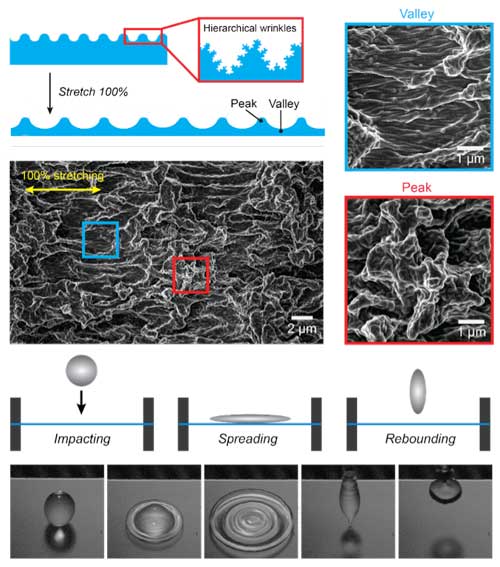| Posted: May 05, 2016 | |
Nanowrinkles are key to stretchable superhydrophobic surfaces |
|
| (Nanowerk Spotlight) Superhydrophobic surfaces that can also withstand mechanical deformation such as bending and stretching are important for applications such as robust self-cleaning, water-resistant electronics, and flexible microfluidics. | |
| One important approach to achieve stretchable superhydrophobic surfaces is to coat an elastomeric substrate with three-dimensional (3D) structures so that the multi-scale roughness can maintain the Cassie-Baxter interface – air pockets formed between a patterned solid and water layer – under stretching. | |
| "The resulting surfaces, however, suffer from two major challenges," Teri W. Odom, Charles E. and Emma H. Morrison Professor of Chemistry and Professor of Materials Science and Engineering at Northwestern University, tells Nanowerk: "First, a lack of flexibility in tailoring the adhesion between the hierarchical structures and underlying substrate because of materials differences; and second, an inability to test the detailed role of structural hierarchy on dynamic superhydrophobicity since precise control of final surface architectures is not possible." | |
| In new results just published in Nano Letters ("Stretchable Superhydrophobicity from Monolithic, Three-Dimensional Hierarchical Wrinkles"), Odom and her group report the design of 3D hierarchical wrinkle substrates that can maintain their superhydrophobicity even after being repeatedly stretched. | |
 |
|
| Complete rebounding of water droplets upon impact occurred on stretched hierarchical wrinkles after 100 % stretching. After stretching, while the valleys of structural hierarchy were deformed parallel to the uniaxial strain, the nanostructures on the peaks of hierarchy maintained. Such partial preservation of 3D wrinkles gave rise to stretchable superhydrophobicity stable under dynamic conditions. (Image: Won-kyu Lee, Northwestern University) | |
| Odom's group has been exploring surface wrinkling as as a powerful method to realize ordered and disordered nanoscale patterns over large areas (see for instance our previous Nanowerk Spotlight: "3D nanopatterning with memory-based, sequential wrinkling"). | |
| In this new work, they use monolithic, multi-scale PDMS nanowrinkles that can exhibit stretchable superhydrophobicity using high fidelity pattern transfer. | |
| "The droplet impact dynamics indicated that droplet rebound depended strongly on the structural hierarchy of the surface," Odom points out. "Surprisingly, on three-generation hierarchical wrinkles, superhydrophobic bouncing was observed with identical droplet spreading and recoiling speed before and after 100% stretching." | |
| The researchers attribute this robust and unusual response to the substrate being able to achieve partial preservation the 3D structural hierarchy under stretching. | |
| Moreover, the monolithic hierarchical wrinkles showed excellent mechanical durability, where no cracking or structural defects were observed even after 1000 stretch-release cycles. | |
| The nanowrinkle material showed wetting properties characteristic of static superhydrophobicity, with water contact angles (> 160°) and very low contact angle hysteresis (< 5°). | |
| "To examine how superhydrophobicity was maintained as the substrate was stretched, we investigated the dynamic wetting behavior of bouncing and splashing upon droplet impact with the surface," explains Odom. "On hierarchical wrinkles consisting of three different length scales, we observed superhydrophobic bouncing. The substrate remained superhydrophobic up to 100% stretching. Stretchable superhydrophobicity was possible because of the monolithic nature of the hierarchical wrinkles as well as partial preservation of nanoscale structures under stretching." | |
| Flexible stretched substrates that remain superhydrophobic under water droplet impact are also crucial in anti-icing, condensation control, and dynamic liquid shedding. | |
| Surfaces that exhibit static superhydrophobicity while stretched, however, cannot guarantee complete water shedding. | |
| The scientists note that, although complete rebounding can occur on stretched surfaces, the breakdown of superhydrophobic bouncing can result at higher impact velocity. | |
| In particular, confirming that droplets rebound in the same manner before and after stretching is important to test stretchable superhydrophobicity. | |
| Hence, the use of impact dynamics characterization to screen surface architectures can provide new insight to design advanced substrates that remain superhydrophobic under mechanical deformation and dynamics conditions. | |
 By
Michael
Berger
– Michael is author of three books by the Royal Society of Chemistry:
Nano-Society: Pushing the Boundaries of Technology,
Nanotechnology: The Future is Tiny, and
Nanoengineering: The Skills and Tools Making Technology Invisible
Copyright ©
Nanowerk LLC
By
Michael
Berger
– Michael is author of three books by the Royal Society of Chemistry:
Nano-Society: Pushing the Boundaries of Technology,
Nanotechnology: The Future is Tiny, and
Nanoengineering: The Skills and Tools Making Technology Invisible
Copyright ©
Nanowerk LLC
|
|
|
Become a Spotlight guest author! Join our large and growing group of guest contributors. Have you just published a scientific paper or have other exciting developments to share with the nanotechnology community? Here is how to publish on nanowerk.com. |
|
